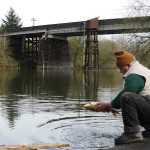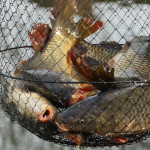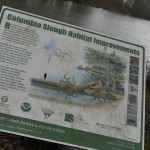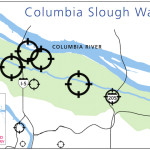Lately the news that for decades two Portland glass companies discharged the toxic chemicals cadmium, arsenic and chromium into the city’s air have filled the media with stories of citizen outrage. State, county and local governments and community groups have suddenly demanded action from the Oregon Department of Environmental Quality (DEQ).
Less talked about is that the same toxic chemicals found in Portland’s air eventually make it into its rivers, lakes and wetlands through the process known as atmospheric deposition (or rain) and become an ingredient in a toxic stew. Local waterways flow with legacy pollutants such as PCB’s and DDT from dirty industrial sites, emerging contaminants like pharmaceuticals and flame retardants, pesticides, and heavy metals like mercury and arsenic from coal fired power plants.
The Columbia Slough is one such locally-affected waterway. The Columbia Slough basin extends from Blue Lake and flows toward Kelly Point Park where it meets the confluence of Willamette and the Columbia River. The Concordia neighborhood is contained in the slough’s watershed.
Today the slough is cleaner than it has been for over a century. The biggest change came in 2000, when the city’s sewers stopped dumping raw sewage and untreated wastewater into the slough during heavy rain storms. Portland’s Department of Environmental Services works with Oregon DEQ to investigate and eliminate sources of fish contamination in the Columbia Slough. They also partner with The Columbia Slough Watershed Council on habitat restoration. There’s a fish consumption advisory, however, on the Columbia Slough and it’s been that way for years.
Pregnant women and children are especially vulnerable to the toxins in the slough’s resident fish. Many Portlanders know that local waters are polluted and they wouldn’t dare eat fish from the Columbia Slough. Other community members, warning or not, have little choice in the matter. The houseless and poor often supplement their diet by eating the most toxic of fish: carp, bass and catfish.
In 2012, Lorri Epstein the Water Quality Director at Columbia Riverkeeper, a non-profit dedicated to protecting the Columbia River, took a catfish from the slough to the lab. The results were stunning. The catfish contained PCBs 27,000 times the Environmental Protection Agency (EPA) limit for unrestricted consumption and flame retardants. A carp from nearby Vancouver Lake tested in 2014 contained PCBs 30 times the EPA limit, mercury 3.5 times the EPA limit, flame retardants and other heavy metals.
“Fish advisories are not the answer. We need to clean up the river and stop toxic pollution from entering our river so that people can eat fish without the fear of getting sick,” said Epstein.
The Portland city council passed a resolution in March 2016 to sue the Monsanto Company for contaminating Portland waterways with PCBs from the 1930-70’s. There are still multiple point sources of arsenic and lead near the Columbia Slough according to recent moss studies. The Oregon Department of Environmental Quality used the studies to pinpoint the glass companies as sources of toxic air pollution. The moss studies could also provide the map the DEQ needs to locate the owners of toxic water sources in the Columbia Slough watershed.



